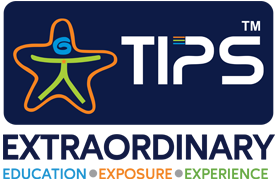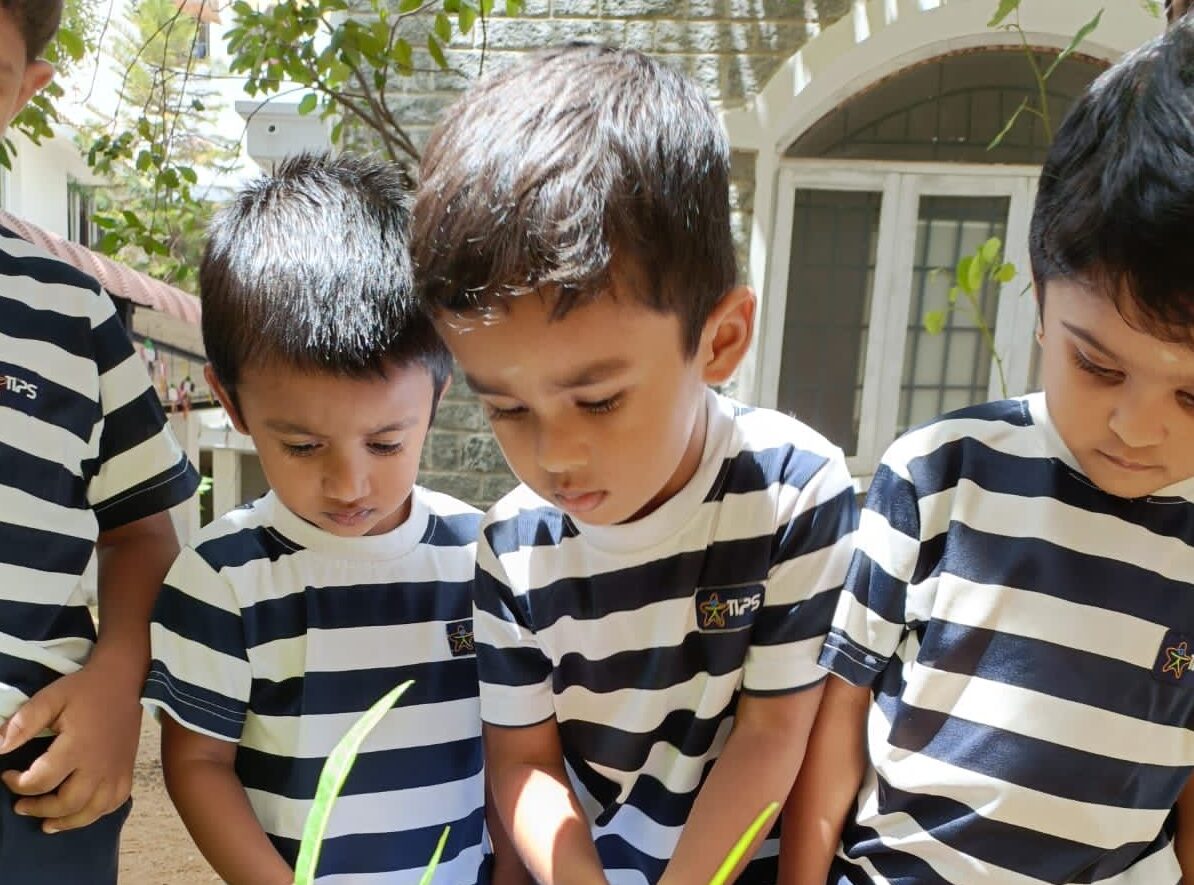- Blog By
Sumita Sen Mazumdar
Principal – Erode KG Campus
The Indian Public School – Erode.
December, 11 2022 | In Blog 
In the early years, children learn by observing and actively engaging with whatever may be around them. This is very much in line with the Montessori theory that there are 4 planes of development, the absorbent mind (birth to 6 years old), the reasoning mind (6+ to 12 yrs), social consciousness (12 to 18 yrs) and transition to adulthood (18 to 24 yrs). Therefore in kindergarten, it is the absorbent mind that we see in the children. They absorb, very much like a sponge, most of what they perceive around them, through their senses.
TIPS KG curriculum makes the most of a child’s natural inclination to do & discover, carefully creating a series of prepared learning environments. In these specially prepared environments including their classrooms, indoor/outdoor activity areas, the children learn through play and movement, encounter a large variety of experiential stimuli for language, math, social skills, executive functioning, emotional development, fine motor and gross motor skills.
Within the absorbent stage, there will be different SENSITIVE periods, where the child shows strong affinity for learning a particular skill. A sensitive period is a time when a child’s brain is most receptive to a certain type of stimulus.

Sensitive periods of development –Cornerstone of early years learning
First theorized by Dutch geneticist Hugo de Vries and subsequently used by the founder of Montessori, Maria Montessori, “sensitive period of development” is the critical time period between birth to around 6 yrs (and can be overlapping) where a child is especially receptive to a certain type of stimuli in their environment. Understanding this is at the very foundation of understanding early years education.
There are 5 types of sensitive periods viz – language, order, sensory skills, motor skills and social skills.
During these periods, a child is exceptionally quick to learn the ability their brain is sensitive to, with the child often unaware that they are “learning something”. This makes the process natural and effortless.
After the sensitive period of development for a particular ability has passed, the development of the brain has matured past the point where information can simply be absorbed for that particular skill. The child must then be “taught” the ability instead of being able to “absorb” naturally in the prepared environment, meaning more conscious effort, but the result not to the same level as could have been achieved had the sensitive period been made use of.
This is why deferring kindergarten learning to age 5+ or above, skipping Playgroup and Pre-KG is not beneficial to the child in the long run.
The first sensitive period of learning is that of language which typically occurs between birth and up to six years of age. During this time, the child characteristically sieves out vocal sounds from their environment, especially human speech, over any other sound. The child then begins to mimic such sounds and form words. If we fail to provide sufficient language stimulation during the child’s language sensitive period, they are most likely to experience language deficits that will require professional help in the form of speech therapy, in the later years.
This makes it important to attend Pre-KG before LKG/KG 1.Pre-KG is for language stimulation activities that must precede reading. In KG 1 according to the curriculum, the child moves to reading in the first term itself. If they have missed the language stimulating listening and speaking activities in PREKG, they struggle to read in KG 1. This struggle unfortunately, may tend to reflect in the later years as well. Mostly, because enough time wasn’t given to the child to master the basics of speech.
In playgroup, we can realistically hope to achieve for a child (non-native speaker of English family) to start speaking 1-2 words for a particular activity or concept, especially the action words and/or the naming word. This is also taking into account the child’s average natural capabilities in the ages of 1 ½ going up to 2 ½ with English not being the mother tongue. In Pre-KG, where children mostly start at 2 ½ up to 3 ½ at the start of the academic year, we can look at language development in children who can speak short sentences with 5-6 words in what we call the SVO pattern. This speaking of the language first, before logically learning the sounds of the alphabet, aka reading is crucial to language fluency and command over oral and written. Firstly, every language has its own syntax which is unique to it. This is not necessarily logical. If that were the case, a literal translation from one language into any other language would have the same meaning. But in practical terms, we see this is not so, implying every language has its own subtle nuances of structure that can be learnt only by speaking the language or oral communication first and during the absorbent phase. Secondly, unless the child understands a language and what they are communicating through it, reading from their perspective is simply a “meaningless” mechanical task that cannot be correlated to actions or objects around them. In the absence of real-world connections in the mind, learning of this kind and especially of a language that is not the mother tongue, is likely to be forgotten almost immediately after the act of trying to memorize is over. The time taken to achieve oral and written fluency by this method to the point of being individually and independently being able to communicate is far too long, with children struggling with language basics beyond primary and sometimes unfortunately in the secondary years too. Kindergarten is the time to build language foundation for English which is the first language in school, as well as Tamil and Hindi. The choice of second language is only to be made in the 6th grade in CBSE and 1st grade in TIPS International path (IB –Cambridge). In Kindergarten, children will be exposed to all 3 languages – English, Tamil & Hindi. For English, they will start with language development activities right from Playgroup and by the year end they can communicate in 1-2 words (for non-native English speakers in such a manner that even a stranger and not just mom/family/ teachers who are familiar with how the child communicates) might understand the words. In Pre-KG, for comprehensive oral English language development, a large variety of listening and speaking activities will be done throughout the year with the sole purpose of getting the children to talk actively in English, responding to a question in a way that makes sense or express a thought, need or emotion. These language activities extend beyond the usual rhymes, songs or storytelling in kindergarten. And what makes it very achievable by the children is our child-centric approach vs. a teacher-centric one where all that is to be done is executed without taking into account the child’s readiness or their individual “pace of learning”. We must understand all children will naturally not be at the exact same stage of readiness in processing new learning. And, in Kindergarten where the foundation of all learning is laid, enough time must be given for each layer of the foundation to form before piling on the next layer or in other words, additional learning. This is not to say that there is any compromise in the learning milestones at TIPS KG, but rather the opposite. Because we move patiently and systematically, giving each child the time and space to assimilate each layer of foundational learning before moving to the next, their understanding and application, and therefore confidence is much higher compared to peers in a traditional teacher-centric learning environment, typically characterized by all children in the classroom memorizing the same learning material. As you can imagine, only a handful of children can thrive in this method and the remaining children, though perfectly capable of achieving similar or even better results had they been in the proper child-centric and prepared environment, fall behind.
The second sensitive period of order typically occurs between the ages of 1 to 3 years. Here we see the child trying to make sense of their environment by organizing received stimuli or information and coming up with conclusions. A child will gravitate to repeating certain activities while actively learning during this process of repetition. There should be minimum interference when the child exhibits the need to repeat actions in this phase because this is their way of internalizing various concepts of spatial, social, sensory, temporal order and if this is missed they have difficulty with concepts that involve logical reasoning later on.
The third sensitive period is that of sensory skills occurring between birth to 4 years. During this sensitive period, the child takes in their environment through different sensory inputs – sight, smell, taste, touch, and hearing. If we keep a child away from the sensory input learning phase, deprived of sufficient sensory stimulation, later on they may experience challenges in processing sensory inputs from their environment. Sensorial learning is therefore a major part of our kindergarten learning environment. Early on the children learn to appreciate the world around them through their senses along with the appropriate contextual vocabulary.
The fourth sensitive period category is motor skills occurring between the ages of 18 months to 4 years. During this period of development, a child learns two types of motor skills: gross and fine. Gross motor skills are physical motor skills involving larger body movements for activities like crawling, walking, jumping or running. Fine motor skills involve the small muscle groups of the hands or wrists, and allow children to hold a pencil, use tweezers or scissors. During this time, a child will also learn hand and eye coordination. If these skills are not developed in the early years, they have difficulty with everyday motor skills later on in life.
The fifth category is social skills. Depending on the child, somewhere, between 2 ½ to 5 years, children will typically show intense interest in social relationships to be part of a group. They start developing friendships and will move to cooperative play after going through individual play and parallel play periods. Coming to school gives every child the right opportunity to develop social skills with other children their own age and also learn how to interact with adults, manners, the concept of respect, learning to wait their turn, etc.

The school environment can adequately support
In order to recognize and support the different sensitive periods in a child’s development, one must first be aware of what is typical for a particular age. This is where the organized school setup to observe and map age-appropriate milestones plays a key role. There may be developmental elements inadvertently being overlooked in the home environment. Gaps happen especially when we cannot recognize that a child is going through a particular sensitive order and must be adequately stimulated. In the kindergarten school environment, teachers are trained to observe and look for these signs, and provide the necessary prepared environment with the right material to maximize the child’s particular sensitive period of skill learning. They would also know the right amount of time to allot for each activity and how to track the skill development while allowing the child to progress at a comfortable pace. At home, there might be a tendency to move in an ad hoc manner in early years, maybe giving stimulus that is premature or a learning environment that is not supportive enough. It might also be a challenge to objectively assess a child’s individual interests, passions or formative needs in the home environment.





Leave a Reply
You must be logged in to post a comment.